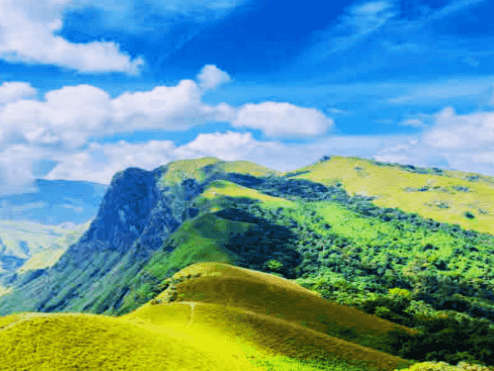My Journey to the Mystical Netravati Trek
Netravati Peak Trek isn’t just another trail—it’s an experience that blends misty valleys, emerald green forests.


Hidden deep in the heart of the Western Ghats, the Netravati Peak Trek isn’t just another trail—it’s an experience that blends misty valleys, emerald green forests, and the raw energy of nature. If you're someone looking to escape the city noise and connect with the untouched wilderness of Karnataka, this trek deserves a spot on your bucket list. Trust me, after completing this trail, your soul will feel lighter, your camera fuller, and your spirit recharged.
Let me take you through everything you need to know—because if you’re planning this adventure, you’ll want more than just pretty pictures. You’ll want the inside scoop.
Starting the Journey: What Makes Netravati Trek Special?
Located in the Chikmagalur district of Karnataka, the Netravati Peak is part of the lesser-known sections of the Western Ghats, making it a hidden gem for nature lovers and serious trekkers. Unlike its more commercial counterparts like Kudremukh or Mullayanagiri, this trail remains relatively untouched—meaning fewer crowds, more wildlife sightings, and a richer forest experience.
What stood out to me was how the landscape kept changing—starting with open grasslands, moving into dense Shola forests, and ending at a panoramic summit that stares into misty nothingness. You won’t just be walking; you’ll be discovering.
Best Time to Visit Netravati Trek: When the Hills Whisper
Monsoon and post-monsoon (June to October) is when the trail comes alive. The forests are lush, the waterfalls thunder down the hillsides, and the air smells of wet earth and adventure. But beware—the trek becomes challenging due to slippery paths and leeches. If you prefer dry and clearer weather, November to February is ideal. You’ll still catch the green cover, but with better trekking conditions and incredible visibility from the peak.
Avoid the summer months (March to May) unless you enjoy the idea of sweating buckets and dealing with parched landscapes. Also, trekking may be restricted during heavy rains by forest authorities, so always check for permissions before planning.
How to Reach the Base: From City Roads to Forest Trails
Your trek begins from Kudremukh National Park, specifically near a small village called Samse. Here's a simple breakdown on how to get there:
From Bangalore: It’s around 330 km. You can either drive down (which I did, and trust me—those winding ghat roads are part of the adventure), or take a KSRTC bus to Kalasa or Kudremukh and hire a local jeep.
Nearest Railway Station: Mangalore (around 120 km away).
Nearest Airport: Mangalore International Airport.
Once you reach the base village, your guide (usually arranged through local trekking groups or forest department-authorized agencies) will assist with permissions and gear checks. Forest permission is mandatory, and local guides help secure it easily. There’s limited network coverage beyond Kalasa, so get your logistics sorted beforehand.
Into the Wild: The Trekking Experience and Route Breakdown
The total trek distance is around 12-14 km (both ways) and takes roughly 6-7 hours, depending on pace and weather. The trail kicks off with gentle slopes, a thick carpet of grass beneath your boots, and a slight mist curling through the trees.
As you ascend, the terrain gets steeper, and the forest denser. The real magic starts after the halfway mark—tiny streams, chirping cicadas, and the distant call of wild animals. I remember pausing often, not out of exhaustion but because I couldn’t stop staring at the beauty around me.
At the summit, the clouds played peekaboo, revealing sweeping views of the Valley of Netravati River, dense canopies stretching endlessly, and faraway hillocks. Some say on clear days, you can even spot the Arabian Sea line from the top.
Pro Tip: Wear full-sleeve clothing and carry salt or Dettol to deal with leeches. They’re harmless but annoying. Also, carry enough water and snacks—there are no shops or facilities en route.
Travel Tips and Itinerary Suggestions: Making It Seamless
Here’s what I’d recommend for an ideal 2-day itinerary:
Day 1:
Leave from Bangalore early morning.
Reach Kalasa by evening. Check into a homestay.
Explore the Horanadu Annapoorneshwari Temple or Soormane Waterfalls nearby.
Day 2:
Early morning start for the Netravati Trek.
Trek duration: 6–7 hours.
Return by late afternoon, freshen up, and begin your journey back.
If you want to explore more, consider combining this with Kudremukh Peak Trek or visiting Hanuman Gundi Falls. The area is full of offbeat forest trails and hidden spots that are perfect for quiet getaways.
Budget and Safety: What You Should Know
One of the best things about the Netravati Trek is how budget-friendly it is. Here’s a rough cost breakdown:
Travel (round trip from Bangalore): ₹1,000–₹1,500 (bus) or ₹2,000–₹3,000 (by car)
Homestay: ₹800–₹1,200 per night
Guide & forest permit: ₹400–₹600 per person
Food: ₹300–₹500 total
So, a 2-day trip can easily be done within ₹2,500–₹4,000 per person.
As for safety, always trek with a guide. The forests are dense and it’s easy to lose track of the trail. Carry basic first-aid, inform someone about your itinerary, and avoid trekking during heavy rainfall.
Final Thoughts: Why Netravati Trek Stays With You
Unlike commercial treks that offer scenic beauty but little peace, Netravati is solitude in its purest form. There’s a soulful stillness on the trail, broken only by the rustling trees and your own heartbeat. It’s not just a trek; it’s a journey through nature’s untouched corridors—where every step connects you to something deeper.
If you’re craving more than just a weekend escape and want a taste of raw, unfiltered wilderness, then pack your bags and head to the Netravati Peak. You won’t come back the same—and honestly, that’s the point.
Leave a comment